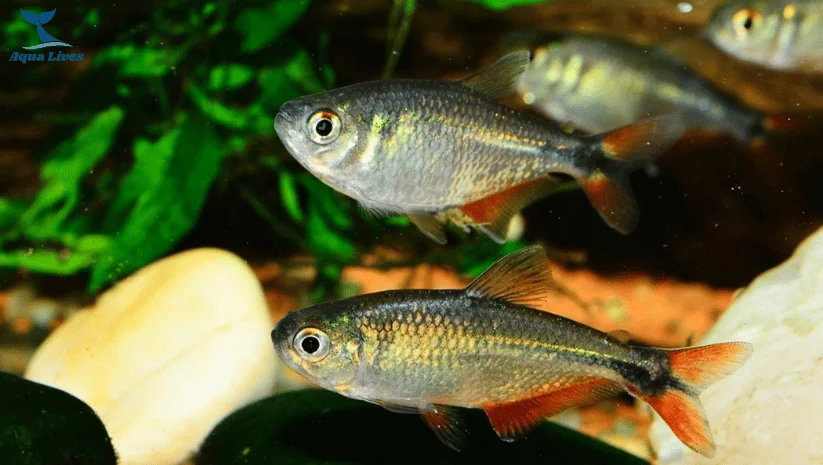The Buenos Aires Tetra is a popular freshwater fish known for its hardiness and vibrant colors. Native to the rivers and streams around Buenos Aires, Argentina, this active and lively fish is a favorite among aquarium enthusiasts. Its striking appearance and relatively easy care make it an excellent choice for beginners and experienced aquarists. The Buenos Aires Tetra’s adaptability and social nature contribute significantly to its popularity in the aquarium hobby.
The Buenos Aires Tetra is scientifically known as Hyphessobrycon argentinenesis.
Origin and Natural Habitat
Buenos Aires Tetras are native to South America, specifically around Buenos Aires, Argentina. They are typically found in rivers and streams with moderate water flow. These natural habitats often feature plenty of vegetation, providing food and shelter for the fish.
Appearance
Buenos Aires Tetras have a sleek, slender body shape and usually reach lengths of around 2.5 inches. They have a silvery body with a slight green tint and are distinguished by their bright red fins, contrasting their overall appearance.
Buenos Aires tetra male vs female
Physical Differences:
- Males: More slender, vibrant coloration.
- Females: Rounder body, especially when carrying eggs.
Behavioral Differences:
- Males: More active and territorial, especially during breeding.
- Females: Generally more subdued.
Tank Setup and Care for Buenos Aires Tetras
Buenos Aires Tetra tank size:
- Minimum 20 gallons for a small group of Buenos Aires Tetras.
Water Conditions:
- Temperature: Temperature: They thrive best within a range of 64°F to 82°F (18°C to 28°C).
- pH Level: Maintain between 6.0 and 8.0.
- Water Hardness: Can adapt to various levels of hardness.
Substrate and Decoration Preferences:
- Substrate: Use fine gravel or sand to mimic natural riverbeds.
- Decoration: Include dense vegetation such as Amazon swords and Java ferns for hiding spots.
- Use driftwood and rocks to create natural shelters.
Social Environment:
- Buenos Aires Tetras are social and thrive in groups of six or more individuals.
- Provide open swimming spaces and areas for them to go to school comfortably.
Buenos Aires Tetra Tank Mates
Buenos Aires Tetras are generally peaceful but can be active swimmers and occasional fin-nippers, especially during feeding or breeding times. When choosing tank mates, consider fish compatible with their behavior and size to ensure a harmonious community tank.
Compatible Tank Mates:
- Other Tetra species such as Neon Tetra and Cardinal Tetra.
- Danios and Rasboras
- Livebearers (Guppies, Swordtails)
- Bottom Dwellers (Corydoras Catfish, Otocinclus Catfish)
- Peaceful Community Fish (Dwarf Gouramis, Freshwater Angelfish, peaceful cichlids like German Blue Ram)
Avoid:
- Long-finned or slow-moving fish
- Aggressive fish like Red Devil Cichlid
Buenos Aires Tetras Food and Feeding
Diet:
- Omnivorous Diet: Buenos Aires Tetras enjoy a varied diet of:
- High-quality flakes or pellets (staple diet).
- Occasional treats of live or frozen foods like bloodworms or brine shrimp.
Feeding Schedule:
- Frequency: Feed small amounts 2-3 times daily.
- Avoid Overfeeding: Feed only what they can consume in a few minutes to maintain water quality.
Tips:
- Variety: Rotate their diet to ensure they receive essential nutrients.
- Monitoring: Observe their feeding behavior to adjust the amount of food accordingly.
Feeding Tips: Offer a variety of foods, including flakes, pellets, and occasional live or frozen treats like bloodworms, to ensure balanced nutrition and vibrant health for your fish.
Behavior
Buenos Aires Tetras are active and social fish known for their energetic swimming and schooling behavior. They feel more secure in groups and often display playful interactions with tank mates. They may occasionally exhibit fin-nipping behavior, especially during feeding or breeding, but are generally peaceful in a well-maintained aquarium environment.
Breeding Buenos Aires Tetras
Breeding Behavior:
- Buenos Aires Tetras display breeding behavior in response to changes in water conditions and increased lighting.
- Males may become more colorful and chase females during courtship.
Spawning:
- Use a separate breeding tank with soft, slightly acidic water (pH 6.0-6.5) and gentle filtration.
- Provide fine-leaved plants or a spawning mop for egg deposition.
Egg Care:
- After spawning, remove the adult tetras to prevent them from eating the eggs.
- Eggs are adhesive and typically hatch within 24-36 hours.
Fry Rearing:
- Feed the fry initially with infusoria or commercial liquid fry food.
- As they grow, they transition to powdered fried food and later to newly hatched brine shrimp or microworms.
Breeding Tank Setup:
- Use a small, shallow breeding tank with subdued lighting.
- Include plants or a spawning mop for egg attachment and provide a gentle water flow.
Health and Disease Prevention
Common Diseases:
- Buenos Aires Tetras are susceptible to diseases like Ich (white spot disease), fin rot, and fungal infections.
Symptoms:
- Signs of illness may include lethargy, loss of appetite, abnormal swimming patterns, visible spots or lesions on the body, and fin deterioration.
Prevention:
- Maintain good water quality through regular water changes and filtration.
- Quarantine new fish before introducing them to the main tank.
- Avoid overcrowding and ensure a balanced diet to boost immune health.
Treatment:
- If the disease is suspected, isolate affected fish promptly.
- Treat with appropriate medications as recommended by a veterinarian or experienced aquarist.
- Follow dosage instructions carefully and complete the entire treatment regimen.
Overall:
The Buenos Aires Tetra is a beloved choice for novice and seasoned aquarists alike due to its hardy nature, striking appearance, and lively behavior. Originating from the rivers of Buenos Aires, Argentina, these tetras thrive in well-maintained aquariums with suitable tank mates and a varied diet. Their social tendencies and adaptability make them ideal for community setups, provided they receive proper care and attention to water quality and nutrition. With their vibrant colors and active schooling behavior, Buenos Aires Tetras add vibrancy and enjoyment to any freshwater tank, making them a rewarding species to care for and observe.

